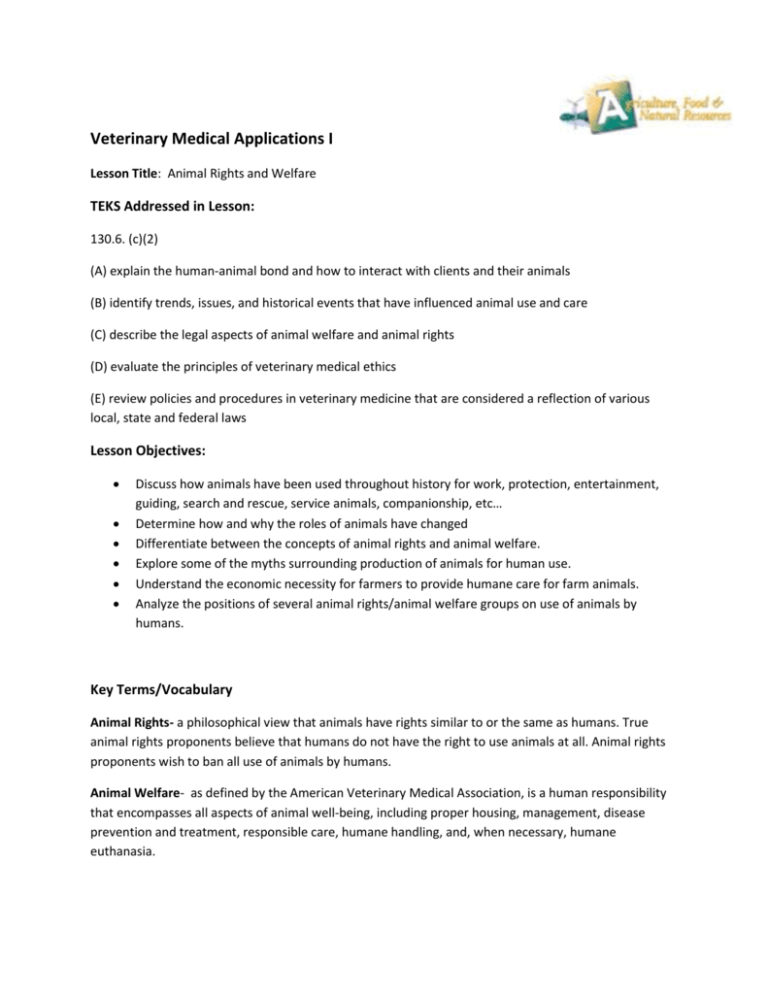Lesson 2A - Animal Rights
advertisement

Veterinary Medical Applications I Lesson Title: Animal Rights and Welfare TEKS Addressed in Lesson: 130.6. (c)(2) (A) explain the human-animal bond and how to interact with clients and their animals (B) identify trends, issues, and historical events that have influenced animal use and care (C) describe the legal aspects of animal welfare and animal rights (D) evaluate the principles of veterinary medical ethics (E) review policies and procedures in veterinary medicine that are considered a reflection of various local, state and federal laws Lesson Objectives: Discuss how animals have been used throughout history for work, protection, entertainment, guiding, search and rescue, service animals, companionship, etc… Determine how and why the roles of animals have changed Differentiate between the concepts of animal rights and animal welfare. Explore some of the myths surrounding production of animals for human use. Understand the economic necessity for farmers to provide humane care for farm animals. Analyze the positions of several animal rights/animal welfare groups on use of animals by humans. Key Terms/Vocabulary Animal Rights- a philosophical view that animals have rights similar to or the same as humans. True animal rights proponents believe that humans do not have the right to use animals at all. Animal rights proponents wish to ban all use of animals by humans. Animal Welfare- as defined by the American Veterinary Medical Association, is a human responsibility that encompasses all aspects of animal well-being, including proper housing, management, disease prevention and treatment, responsible care, humane handling, and, when necessary, humane euthanasia. Interest Approach/Anticipatory Set Discuss movies with strong connection between animal/owner such as Hachi. Were the animals harmed in the making of these movies/shows? Conduct an opening discussion with students on the distinction between rights and welfare. Have students list some rights which they have as a U.S. citizen such as free speech. Next, have the students identify some measures which ensure their welfare (examples: education, health care, etc) now does it make sense to you all that all animals should have the same rights as people? Further Discussion Points: How animals have been used throughout history for work, protection, entertainment, guiding, search and rescue, service animals, companionship, etc? How and why the animal’s roles have changed over time? Ask students if the lesser need for using animals for work/protection increased the bond between humans and animals Show students two videos showing the opposite sides of animal treatment. The fi rst video is one from PETA, the other is a video of the “Happy Cows Come from California” campaign. Show the fi rst video entitled “Who cares about Mice and Rats?” http://www.youtube.com/watch?v=Zjo-Kp5rekQ Follow that up with the “California Cows Singing” http://www.youtube.com/watch?v=YzZeZf5suq8 Teaching Plan and Strategy Presentation of New Material Animals were essential to the survival of early American settlers, they provided transportation, food, clothing, protection, etc.. Many uses of animals have been criticized over the years such as farming, zoos, rodeos, use in media, guide dogs, search and rescue… Explain to students the definition of animal rights and animal welfare as well as their beliefs and organizations associated with each. 1. Animal welfare a. Animal welfare supporters: i. improve the treatment and well-being of animals. ii. believe that humans can interact with animals if the proper care and management for all animals is involved. iii. use science to determine effective care and safe handling procedures. 2. Animal rights a. support laws and regulations that would prohibit: i. rodeos ii. horse racing iii. circuses iv. hunting v. life-saving medical research using animals vi. raising of livestock for food Discuss welfare laws that were passed as far back as 200 years in order to protect the treatment of animals. (Students could use devices at this point to search for legislation on this topic) Discuss how the media affects agricultural facilities and discuss the treatment of animals in the agricultural industry-examples include: slaughter houses, clipping chicken wings, giving injections, youtube videos being accurate. Does this play a role in the decision of some to become vegetarian? Or vegan? Give students a copy of a handout “Myths and Facts.” (I composed this list in order to attest to the media’s portrayel of animal agriculture) Many questions may arise from this discussion as to the actual practices used by farmers to raise food animals. Students may gain more understanding of production methods by participating in a farm tour. They would have opportunities to observe firsthand how particular animals are cared for in production agriculture. An alternative experience would be to invite livestock farmers to come into the class to describe their farm practices and answer questions regarding common myths about animal care. Have students use the “Animal Agriculture: Myths & Facts” handout to ask questions of the classroom presenter. Activity/Application/Student Engagement/Laboratory Students should take 45 minutes to research various aspects of animal rights and welfare. They should discover headlines in the media that discuss events throughout history, legislation related to agricultural animals, animals used for testing, The ASPCA, PETA,eta…students should be able to explain the beliefs and actions of both rights and welfare parties. Upon completion of research, divide students into two groups and have them debate the issue of Animal Rights vs. Welfare. The debate can be started by having one student make a statement accusing the other side of being unethical or too radical and the other side could have the opportunity to defend or counter the accusation. Evaluation/Summary/ Assignment The final activity in this exploration of animal rights/animal welfare issues is a research project where students are asked to gather information regarding the beliefs and policies of different organizations. Have students write to a sampling of animal welfare/rights organizations requesting literature on their positions regarding animal use and care. Ask students to compare and contrast the different organizations’ positions and evaluate the validity of their beliefs. This activity could include both a written report and presentation of findings to the class. An alternative to the research paper is to instruct students to create a public service announcement to depict the information gained from this lesson. PowerPoint, Prezi or Animoto (sign up for educator account) to create the PSA. Students should include the same information that would have been included in the research project. The students’ levels of comprehension of the different positions on animal rights/welfare can be assessed by their written reports and presentations on the issues. Students will demonstrate the ability to hear and discuss differing viewpoints on an issue and communicate their opinions in an organized manner in both written and oral forms. References/Additional Materials/Extended Learning Opportunities/Enrichment Cornell Pork Check Off http://spot.humaneresearch.org/node “Animal Agriculture: Myths & Facts”, Animal Industry Foundation, 1988. College and Career Readiness Standards: Science I. B1 Design and conduct scientific investigations in which hypotheses are formulated and test. (a-g) I. C1 Collaborate on joint projects III. C 1 Presentation of scientific/technical information IV. C2 Recognize the role of people in important contributions to scientific knowledge Reading II.A 4 Draw and support complex inferences from text to summarize, draw conclusions, and distinguish facts from simple assertions and opinions. II.A 5 Analyze the presentation of information and the strength of quality of evidence used by the author, and judge the coherence and logic of the presentation and the credibility of an argument. V. A Formulate topic and questions V. B Select information from a variety of sources V. C Produce and design a document








